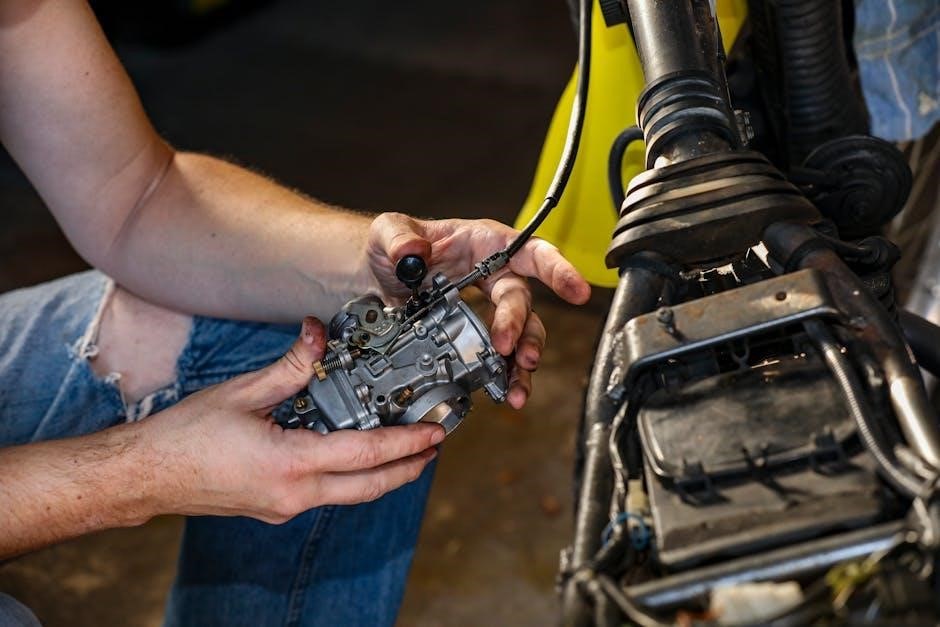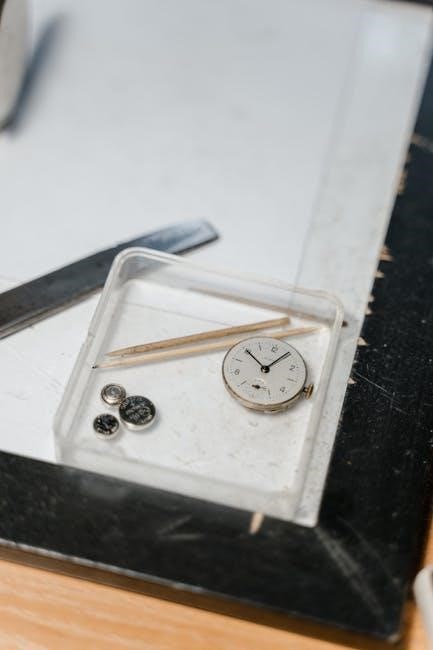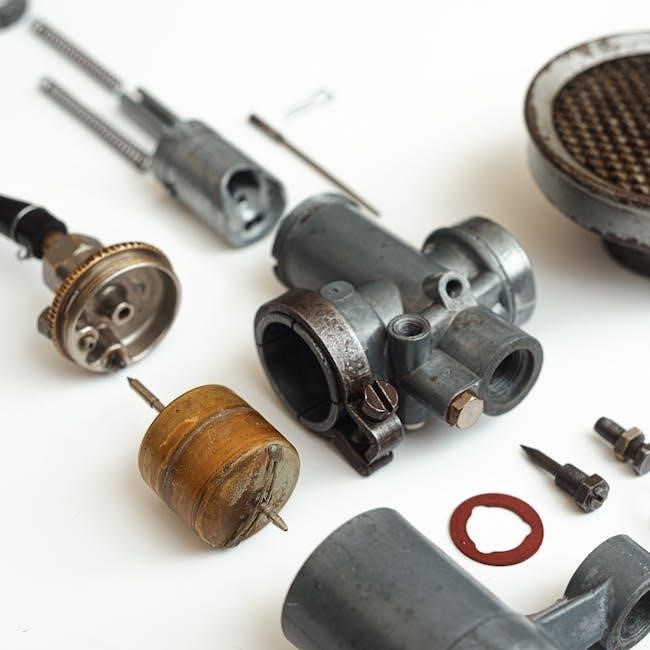Dyna-Glo Heater Parts Manual: A Comprehensive Guide
A Dyna-Glo heater parts manual is vital. It provides detailed information on components, aiding in maintenance and repairs. This guide helps users locate specific parts, troubleshoot, and ensure safe operation. It offers diagrams and lists for parts identification.
Understanding the Importance of the Dyna-Glo Heater Parts Manual
The Dyna-Glo heater parts manual is an indispensable resource for anyone owning or maintaining a Dyna-Glo heater. Its significance stems from several key factors. First and foremost, it serves as a comprehensive guide to understanding the intricate workings of your specific Dyna-Glo heater model. This understanding is crucial for effective troubleshooting and repair. Without the manual, diagnosing issues and identifying the correct replacement parts can be a daunting task, potentially leading to costly mistakes or even safety hazards. The manual provides detailed diagrams and exploded views, allowing you to visually inspect each component and understand its function within the overall system.

Furthermore, the parts manual is essential for ensuring the longevity and optimal performance of your Dyna-Glo heater. Regular maintenance, guided by the manual, can prevent minor issues from escalating into major problems. The manual outlines recommended maintenance procedures and schedules, helping you keep your heater in top condition. It also provides critical safety information, including warnings and precautions, to prevent accidents and ensure safe operation. By adhering to the guidelines in the manual, you can minimize the risk of fire, electric shock, or other hazards.
Moreover, the Dyna-Glo heater parts manual simplifies the process of ordering replacement parts. It lists all the components of your heater, along with their corresponding part numbers. This information is invaluable when contacting a parts supplier or searching online for replacements. By using the correct part numbers, you can avoid ordering the wrong parts, saving time and money. The manual also provides information on accessories and optional components that can enhance the functionality of your heater. In essence, the Dyna-Glo heater parts manual is a vital tool for anyone who wants to keep their heater running smoothly, safely, and efficiently for years to come. It empowers you to take control of your heater’s maintenance and repair, saving you money on professional service calls and ensuring the comfort and safety of your home or workspace.

Locating and Downloading Dyna-Glo Heater Manuals
Finding the correct Dyna-Glo heater manual for your specific model is crucial for proper maintenance, troubleshooting, and parts identification. Fortunately, there are several avenues you can explore to locate and download these essential documents. The first and often most reliable source is the official Dyna-Glo website. Navigate to their support or customer service section, where you should find a searchable database of manuals. You’ll typically need your heater’s model number, which is usually located on a sticker or plate on the heater itself. Enter this number into the search bar to retrieve the correct manual for your unit.

If you are unable to find the manual on the Dyna-Glo website, consider checking online retailers that sell Dyna-Glo heaters. Many of these retailers, such as Amazon, Home Depot, or Lowe’s, often provide links to the product manuals on their product pages. Simply search for your heater model on their website and look for a “Manuals” or “Downloads” section. Additionally, you can try searching for your manual on general online document repositories like ManualsLib or ManualsOnline. These websites often host a wide variety of user manuals and parts lists for various appliances and equipment, including Dyna-Glo heaters. Use the model number of your heater in your search query to narrow down the results.
Another useful approach is to perform a targeted Google search. Type “Dyna-Glo heater manual” followed by your specific model number into the search bar. This often yields direct links to PDF versions of the manual hosted on various websites. When downloading manuals from unofficial sources, exercise caution and ensure that the website is reputable to avoid downloading malware or incorrect documents. Once you’ve located the correct manual, download it to your computer or mobile device for easy access. Consider saving it in multiple locations or printing a hard copy for safekeeping. Having the manual readily available will prove invaluable when you need to perform maintenance, troubleshoot issues, or order replacement parts for your Dyna-Glo heater.
Key Sections Typically Found in a Dyna-Glo Heater Parts Manual
, which provides an overview of the heater’s features, intended use, and important safety precautions. This section often includes warnings and cautions that users should carefully read and understand before operating the heater. Following the introduction, you’ll usually find a detailed Safety Information section. This section outlines specific hazards associated with the heater’s operation, such as the risk of fire, burns, or carbon monoxide poisoning. It provides guidelines for safe usage, ventilation requirements, and instructions for handling fuel (if applicable).
The Operating Instructions section offers step-by-step guidance on how to properly start, operate, and shut down the heater. This includes instructions for filling the fuel tank (if applicable), adjusting the heat settings, and using any special features or controls. Clear diagrams and illustrations are often included to aid in understanding the operating procedures. A crucial part of the manual is the Parts List and Exploded Diagrams section. This section provides a detailed breakdown of all the heater’s components, with each part labeled and identified by a specific part number. Exploded diagrams illustrate how the parts fit together, making it easier to identify and order replacement parts. The Troubleshooting Guide is another essential section. It lists common problems that users may encounter, along with possible causes and solutions. This section can help users diagnose and fix minor issues without the need for professional assistance.
The Maintenance and Cleaning section provides instructions on how to properly maintain and clean the heater to ensure its longevity and optimal performance. This includes information on cleaning the burner, inspecting the fuel lines, and lubricating moving parts. Finally, the manual typically includes a Warranty Information section, which outlines the terms and conditions of the manufacturer’s warranty. This section specifies what is covered under warranty, how to make a warranty claim, and the duration of the warranty period. By carefully reviewing all of these key sections, users can gain a thorough understanding of their Dyna-Glo heater and ensure its safe and efficient operation.
Troubleshooting Common Issues Using the Parts Manual
The Dyna-Glo heater parts manual is an invaluable tool when troubleshooting common issues. When your heater isn’t working as expected, the manual provides a structured approach to diagnosing and resolving the problem. Begin by consulting the Troubleshooting Guide section, which typically lists a variety of symptoms, such as “heater won’t start,” “low heat output,” or “unusual noises.” For each symptom, the manual will suggest potential causes and corresponding solutions. For instance, if your Dyna-Glo heater fails to ignite, the manual might suggest checking the fuel level, inspecting the igniter, or ensuring proper airflow. The manual’s detailed diagrams and parts lists become particularly useful when a specific component is suspected. Let’s say the troubleshooting guide points to a faulty igniter. You can use the exploded diagrams to locate the igniter within the heater assembly and identify its corresponding part number in the parts list.
This allows you to confirm that you’re targeting the correct part for inspection or replacement. If the heater produces low heat, the manual might advise checking the burner for obstructions or inspecting the gas valve for proper operation. Again, the diagrams help you pinpoint these components and understand their function within the overall system. Suppose you determine that the burner is clogged. The parts manual may include instructions on how to disassemble the burner assembly for cleaning. It’s crucial to follow these instructions carefully to avoid damaging any components. If a part needs replacement, the manual provides the exact part number to ensure you order the correct replacement from a supplier. Furthermore, the troubleshooting section often includes safety precautions related to specific issues.
For example, if there’s a fuel leak, the manual will emphasize the importance of shutting off the fuel supply and ventilating the area before attempting any repairs. By systematically following the troubleshooting steps outlined in the Dyna-Glo heater parts manual and utilizing the diagrams and parts lists, you can effectively diagnose and resolve many common heater problems. This not only saves you time and money on professional repairs but also ensures the safe and efficient operation of your heater. Always remember to disconnect the heater from its power source or fuel supply before performing any troubleshooting or repairs.
Identifying Replacement Parts Using the Manual
The Dyna-Glo heater parts manual is an indispensable resource for accurately identifying replacement parts. When a component of your heater fails or becomes damaged, the manual provides the necessary information to ensure you order the correct replacement, avoiding costly mistakes and delays. The key to successful parts identification lies in the manual’s exploded diagrams and accompanying parts lists. Exploded diagrams are detailed illustrations that show how all the individual components of the heater fit together. These diagrams typically provide a clear visual representation of the heater’s assembly, making it easy to locate the specific part you need to replace. Each part in the diagram is labeled with a number, which corresponds to an entry in the parts list. The parts list is a table that provides a detailed description of each component, along with its unique part number.
To identify a replacement part, first locate the component on the exploded diagram. Once you’ve found the part, note its corresponding number. Then, refer to the parts list and find the entry with the matching number. The parts list will provide the official Dyna-Glo part number, a brief description of the part, and sometimes the quantity required. This information is crucial when ordering the replacement part from a supplier. It ensures that you receive the exact component needed for your specific Dyna-Glo heater model. For example, suppose you need to replace the igniter on your heater. You would first find the igniter on the exploded diagram and note its number, let’s say “15.” Then, you would look up number “15” in the parts list. The parts list entry might read: “15. Igniter, Part Number DG12345.” This tells you that the correct part number for the igniter is DG12345. Using this part number, you can confidently order the replacement igniter from a Dyna-Glo parts supplier.
The manual also helps to differentiate between similar-looking parts. Sometimes, two components may appear almost identical but have different functionalities or dimensions. The parts list provides detailed descriptions that help you distinguish between these parts. Always double-check the part number and description to ensure you’re ordering the correct replacement. Furthermore, the Dyna-Glo heater parts manual often includes model-specific information. Different Dyna-Glo heater models may use different parts, even if they look similar. The manual will specify which parts are compatible with your particular model, preventing you from ordering incompatible components. By carefully utilizing the exploded diagrams, parts lists, and model-specific information in the Dyna-Glo heater parts manual, you can confidently identify and order the correct replacement parts, ensuring that your heater is repaired efficiently and safely.
Safety Precautions Outlined in Dyna-Glo Heater Manuals
Dyna-Glo heater manuals place a significant emphasis on safety, providing users with essential guidelines to prevent accidents and ensure the safe operation of their heating appliances. These precautions are not merely suggestions; they are critical instructions that must be followed to protect yourself, your family, and your property. The manuals typically begin with a prominent warning section, highlighting the potential hazards associated with improper heater use. These warnings often cover topics such as the risk of fire, burns, carbon monoxide poisoning, and electrical shock. It is imperative to read and understand these warnings before operating the heater. One of the most frequently emphasized safety precautions is the importance of proper ventilation. Dyna-Glo heaters, particularly those that burn fuel such as kerosene or propane, can produce carbon monoxide, a colorless and odorless gas that can be deadly. The manuals strongly advise using the heater only in well-ventilated areas to prevent the buildup of carbon monoxide. They often recommend using a carbon monoxide detector to monitor the air quality and provide an early warning if dangerous levels are detected.
Another crucial safety precaution outlined in Dyna-Glo heater manuals is maintaining a safe distance between the heater and flammable materials. The manuals specify a minimum clearance distance, typically several feet, that must be maintained between the heater and items such as furniture, curtains, paper, and clothing. This clearance helps to prevent fires caused by radiant heat from the heater igniting nearby combustibles. The manuals also address the safe handling and storage of fuel. For kerosene and propane heaters, they provide instructions on using the correct type of fuel, filling the fuel tank safely, and storing fuel containers properly. They typically advise against overfilling the fuel tank, using fuel that is contaminated or old, and storing fuel containers near heat sources or open flames. Electrical safety is another important aspect covered in Dyna-Glo heater manuals. For electric heaters, the manuals provide instructions on using the correct voltage, avoiding overloading circuits, and inspecting the power cord for damage. They often recommend using a ground fault circuit interrupter (GFCI) outlet in damp or wet locations to prevent electrical shock. Furthermore, the manuals emphasize the importance of regular maintenance and inspections. They provide instructions on cleaning the heater, checking for leaks or damage, and replacing worn or damaged parts. Proper maintenance helps to ensure that the heater operates safely and efficiently and reduces the risk of malfunctions or accidents.
Dyna-Glo heater manuals also include specific safety instructions for different types of heaters. For example, manuals for propane heaters may include instructions on checking the gas connections for leaks and using a propane leak detector. Manuals for kerosene heaters may include instructions on properly maintaining the wick and avoiding the use of improper fuels. It is crucial to read and follow the safety instructions that are specific to your particular Dyna-Glo heater model. Finally, Dyna-Glo heater manuals often remind users to never leave the heater unattended while it is operating and to keep children and pets away from the heater. These precautions help to prevent accidents caused by accidental contact with the hot surfaces of the heater or by children tampering with the controls. By carefully following the safety precautions outlined in Dyna-Glo heater manuals, users can significantly reduce the risk of accidents and enjoy the warmth and comfort of their heaters safely.
Maintenance Procedures Described in the Manual
Dyna-Glo heater manuals dedicate a significant portion to outlining essential maintenance procedures designed to prolong the lifespan of the heater, maintain its efficiency, and ensure safe operation. These procedures are not merely suggestions but are crucial steps that users should regularly undertake to prevent potential issues and keep their heaters functioning optimally. The manuals typically provide a detailed schedule for maintenance tasks, specifying how often each task should be performed, whether it’s daily, weekly, monthly, or annually. One of the most common maintenance procedures described is cleaning the heater. Dust, dirt, and debris can accumulate on the heater’s surfaces, particularly around the burner and air vents, hindering its performance and potentially creating a fire hazard. The manuals provide instructions on how to safely clean these areas, typically recommending the use of a soft cloth or brush and, in some cases, a vacuum cleaner. It is crucial to ensure that the heater is turned off and completely cooled down before cleaning to avoid burns or electrical shock.
For kerosene heaters, the manuals emphasize the importance of wick maintenance. The wick is responsible for drawing fuel up to the burner, and over time, it can become clogged with carbon deposits or other contaminants. The manuals provide instructions on how to clean the wick, typically involving burning off the excess carbon or, in some cases, replacing the wick entirely. Proper wick maintenance is essential for ensuring a clean and efficient burn and preventing the buildup of soot or smoke. Propane heaters require different maintenance procedures, such as checking the gas connections for leaks. The manuals provide instructions on how to perform a leak test using a soapy water solution and how to tighten the connections if leaks are detected. It is crucial to address any gas leaks promptly to prevent the risk of fire or explosion. Electrical heaters also require regular maintenance, such as inspecting the power cord for damage. The manuals provide instructions on how to check the cord for fraying, cracks, or other signs of wear and tear. A damaged power cord can pose an electrical shock hazard, so it is essential to replace it immediately if any damage is found.

In addition to cleaning, wick maintenance, and leak checks, Dyna-Glo heater manuals may also describe other maintenance procedures, such as lubricating moving parts, inspecting the burner for corrosion, and checking the safety controls to ensure they are functioning correctly. The manuals typically provide detailed instructions and diagrams to guide users through each procedure, making it easy to perform the maintenance tasks safely and effectively. Furthermore, the manuals often include a troubleshooting section that addresses common issues and provides solutions. This section can be a valuable resource for diagnosing and resolving problems before they escalate into more serious issues. By following the maintenance procedures outlined in Dyna-Glo heater manuals, users can ensure that their heaters operate safely and efficiently for years to come, providing reliable warmth and comfort whenever needed.
